This National Monument Looks Like A Greek Temple, But Is Actually Our First Medical College
What is a National Monument? Who gazettes them? How many national monuments are there in Singapore? To date, the Preservation of Sites and Monuments, a division of National Heritage Board, has identified and gazetted 76 buildings, structures and sites of national significance as an integral part of Singapore’s built heritage.
And we're here to tell you all about them - one National Monument at a time!
You've probably passed by or stepped into more than a few of them without realising they were National Monuments: Al-Abrar Mosque, Asian Civilisations Museum, the Civilian War Memorial, Saint Andrew's Cathedral, the Esplanade Park Memorials, Fort Siloso on Sentosa - no need to plan an itinerary for friends visiting from overseas; just show them this article ✌️
In this edition, we zoom in on the first school of medicine in British Malaya (present-day Malaysia and Singapore), the College of Medicine Building.
📍 Location
The College of Medicine Building was the 47th building to be gazetted as a National Monument, and is located near other National Monuments such as Tan Teck Guan Building, and Bowyer Block. The MRT station nearest to the College of Medicine Building is Outram Park.
📅 Significant dates
Dates built:
- 1905: The Straits and Federated Malay States Government Medical School was built
- 1923-1926: The College of Medicine Building (then known as King Edward VII College of Medicine) was built
Milestones:
- 1913: The Straits and Federated Malay States Government Medical School was renamed King Edward VII Medical School
- 1921: It was renamed again to King Edward VII College of Medicine
- 15 Feb 1926: The College of Medicine Building was officially opened
Date gazetted: 2 Dec 2002
📜 History
Singapore’s initial Western-trained doctors were predominantly from Britain and India. With the local population growing and the expansion of medical services, the British Administration began sending qualified young men to Madras Medical College in India for training as assistant surgeons. In 1889, Principal Civil Medical Officer Max Simon put forth a suggestion for establishing a medical school in Singapore.
Although the school was established the following year, the success rate for the preliminary entrance examination was dismally low, with only two students passing and being admitted in 1891. Consequently, the plan for a medical school was abandoned, and prospective candidates continued to train in Madras.
Over a decade later, a renewed effort to establish a medical school was led by the successful Peranakan merchant Tan Jiak Kim. Along with representatives from various non-European communities, he petitioned the Governor of the Straits Settlements, Sir John Anderson, to establish a medical school in Singapore.
The old Female Lunatic Asylum at Sepoy Lines (now near the junction of Outram Road and New Bridge Road) was then converted into a medical school, fully equipped with classrooms, offices, laboratories, and dissection rooms. Thus, in 1905, the Straits and Federated Malay States Government Medical School was established.
This marked a significant milestone in Singapore's public health history, as local men and women could finally receive proper training in Western medicine without leaving the country.
Following a donation from the King Edward VII Memorial Fund the previous year, the school was renamed King Edward VII Medical School in 1913. Over the years, the school expanded and, in 1921, it was renamed once more as King Edward VII College of Medicine.
In 1920, the British Administration approved the construction of a new building for the medical college, appointing Major P. H. Keys as the architect. Construction began in 1923 and was completed three years later. The building was officially opened by the Governor of the Straits Settlements, Sir Laurence N. Guillemard, on 15 Feb 1926. This grand building housed various facilities including lecture rooms, laboratories, and even a museum.
The School of Dentistry and the School of Pharmacy were established in 1929 and 1935, respectively. Tan Teck Guan Building, adjacent to the College of Medicine Building, accommodated the Department of Anatomy. In 1949, the College of Medicine merged with Raffles College to form the University of Malaya, with the former becoming its Faculty of Medicine.
Major renovation works were undertaken between 1985 and 1987 to restore the College of Medicine Building to its original splendour. Today, the building houses the Ministry of Health, the Singapore Medical Council, and the College of Family Physicians (previously known as the College of General Practitioners).
 IMAGE: NG KAI
IMAGE: NG KAI
📐 Design and architecture
The Neoclassical structure resembles the Former City Hall. One striking feature of the College of Medicine Building is the row of colossal, fluted Doric columns adorning the front facade.
The façade walls also showcase friezes (broad horizontal bands of sculpted or painted decorations) that depict the teaching and practice of medicine in Ancient Greece. These friezes were designed by Cavaliere Rudolfo Nolli, who also created the decorative sculptures on the facade of the Former Supreme Court and were carved by J. Sharpe Elliot.
 IMAGE: NG KAI
IMAGE: NG KAI
Above the main entrance, there is an intricate bas-relief (a type of art in which shapes are cut from the surrounding stone so that they stand out slightly against a flat surface) of a Roman eagle, signifying the civil or official status of the building.
🎟️ Admission
Entry is prohibited to members of the public.
For the latest updates on Wonderwall.sg, be sure to follow us on TikTok, Telegram, Instagram, and Facebook. If you have a story idea for us, email us at [email protected].









